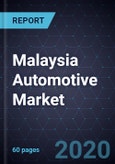Passenger Vehicle Sales Continue to Increase, Bringing 0.7% Year-on-Year Growth to the Entire Automotive Industry
From 2018 to 2019, the Association of Southeast Asian Nations (ASEAN) automotive market decreased by 2.9% year-on-year (YoY), and total sales reached 3.5 million units. The main reasons include the direct impact of the global economic slowdown on automotive sales, and the decline in sales faced by Indonesia (by political activities), which is the leader of the ASEAN, with a 29.8% share.
In 2019, Malaysia’s total industry volume (TIV) achieved 604,290 units. It is expected to increase to 608,800 units by 2020, with an increase of 0.7% year-on-year (YoY). Gasoline powertrain dominates the Malaysian automotive market with a market share of 82.6%.
In Malaysia, the passenger vehicle market is dominated by passenger cars and sport-utility vehicle (SUV) segments, accounting for 69.5% and 22.5% of the share, respectively. This is followed by multi-purpose vehicles (MPVs) and window vans, with a combined share of 8%. MPVs, in particular, have lost their market attractiveness, falling from 12.3% of the share in 2018. The main reasons include market competition of new SUV models and affordable prices offered by SUVs.
The commercial vehicle market decreased by 17.4% from 65,510 units in 2018 to 54,110 units in 2019. The pickup was highly popular and accounted for 64.5% of the share in 2019. This was followed by trucks (23.2%) and panel vans (8.3%).
A total of 9,760 electric vehicles were sold in Malaysia. Plug-in hybrid electric vehicles (PHEVs) accounted for 98.9% of battery electric vehicles (BEVs) which accounted for 1.1%. Low fuel prices and lack of direct incentives have led to low BEV adoption. Premium OEMs, especially BMW is the main contributor, accounting for 78.8% of the share.
In Malaysia, the shared mobility market is concentrated in Klang Valley, Johor Bahru, and George Town. The eHailing market has undergone a transformation by obtaining a Public Service Vehicle (PSV) license. Its growth has been challenged by the mandatory regulations of the Malaysian government. Its fleet decreased from 209,100 vehicles in 2018 to 101,080 vehicles in 2019. Nevertheless, it is expected that the fleet size will increase by 2020.
Comparatively, oBike and Mobike canceled bicycle-sharing operations in Malaysia in 2019. LinkBike continues to operate in George Town with a total of 250 bicycles. eScooter sharing operators including Beam, Tryke, and Neuron Mobility which began to penetrate Malaysia in 2019.
Smartphone connectivity is the basic feature of connected passenger vehicles and connected commercial trucks. The connected mobility market will focus on the use of in-vehicle applications and remote access to vehicles. Anti-theft, fuel monitoring and cargo safety are the expected features required in Malaysia.
Research Scope
This study aims to provide a strategic outlook of the automotive industry including both commercial and passenger vehicles in Malaysia. It offers a snapshot of the current automotive market in Malaysia. It presents current scenarios in the sharing mobility industry, including eHailing, car sharing, bicycle-sharing, and eScooter sharing services. It provides a market overview between 2018 and 2020.
Research Objectives
- To provide a strategic overview of the passenger and commercial vehicle market in Malaysia.
- To present and predict total industry volume of the passenger and commercial vehicle market in Malaysia towards 2020.
- To offer a current market overview of the Malaysian shared mobility industry.
- To provide a snapshot of the Malaysian connected mobility industry.
- To present Government policies and future trends towards automotive and shared mobility industry in Malaysia.
Key Issues Addressed
- What are the current scenarios and future trends of the automotive and shared mobility segments in Malaysia?
- What are the Government regulations of the automotive and shared mobility industries in Malaysia?
- What is the current status of electric vehicles (EVs) and EV-related industries in Malaysia?
- Who are the key market participants in the automotive and shared mobility segments in Malaysia?
- Who are the main market players in the connected vehicle industry in Malaysia?
Table of Contents
Companies Mentioned (Partial List)
A selection of companies mentioned in this report includes, but is not limited to:
- Beam
- BMW
- LinkBike
- Mobike
- Neuron Mobility
- oBike
- Tryke








